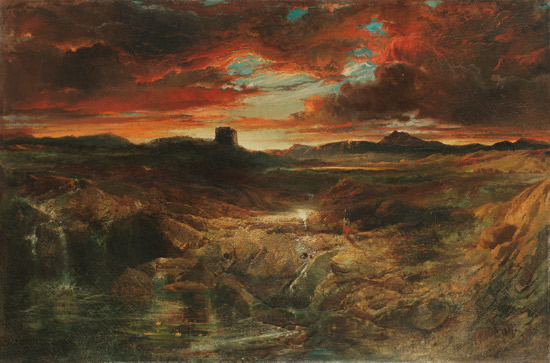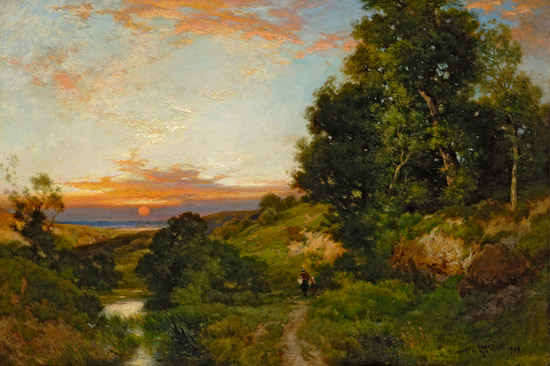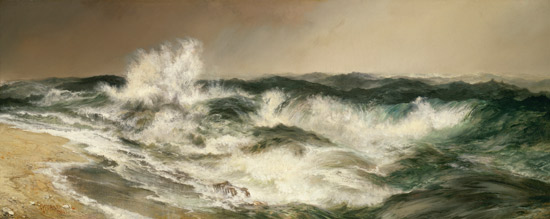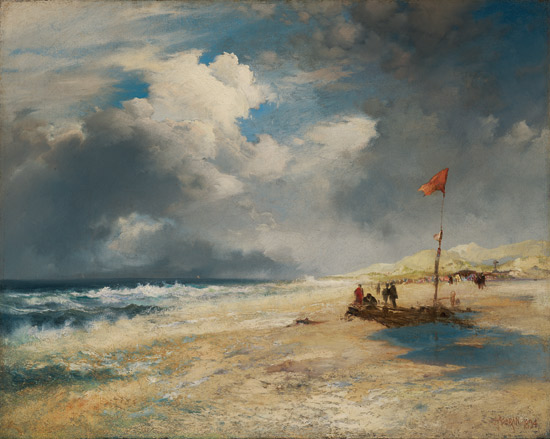DISPATCH - OCT 25, 2013
EAST HAMPTON, NY-
Guild Hall is opening a major exhibition featuring the paintings of Thomas Moran. The exhibition “Tracing Moran's Romanticism & Symbolism” opens on Oct. 26, 2013 and continues through Jan. 5, 2014. Moran (1837 – 1926) was a major landscape artist whose studio was located on East Hampton’s Main Street. The exhibition focuses on Moran’s use of romanticism and symbolism in works made from 1859 to 1917. The show is curated by art critic Phyllis Braff.
“Responsive to the sensibilities of his era, Moran found inspiration in poetry, mythology, popular literature and in a range of issues current in the national dialogue,” stated Braff. “He often treated sky phenomena, bodies of water and buildings as pictorial elements that would enhance the relevance of his art to the viewers of his own time. Like other followers of Romantic traditions, he was interested in connecting at an emotional level."
.
.
Moran was a central figure in several phases of American landscape painting, according to Guild Hall. His paintings of geological marvels west of the Mississippi helped the United States define its national identity after the Civil War. As industrialization began to spread, Moran’s paintings of nature provided an accessible and direct experience and reflected a developing nostalgia among urban residents for the serenity of rural places.
Moran received the moniker of “One of the fathers of the National Parks” after 1872—the year that geologists made use of Moran’s watercolor studies of Yellowstone to successfully argue for legislation protecting the vast unspoiled regions. Congress subsequently purchased Moran’s large painting, "The Grand Canyon of the Yellowstone." This was the first work acquired for the Capitol and an event that brought widespread publicity and celebrity. The painting is now in the care of the National Museum of American Art.
.

"Childe Roland to the Dark Tower Came" by Thomas Moran, 1859. Oil on canvas, 29 1/4 x 44 1/8 inches. Questroyal Fine Art. LLC, New York.
.
In 1884, Moran designed and built a workplace/residence on East Hampton's Main Street. For the next 40 years, many of his major works were painted in the structure that he called "The Studio."
“Tracing Moran's Romanticism & Symbolism” sprung from Guild Hall Museum’s interest in offering a "collection-in-context" presentation. The museum owns four oil paintings, three watercolors, and 20 works on paper by Moran. Contributing to the focus is Jonathan Scott Hartley's 1891 bust of Moran and Howard Russell Butler's oil portrait of Moran, circa-1922.
.

"Approaching Storm, East Hampton" by Thomas Moran, 1878. Oil on mahogany panel, 4 3/4 x 8 inches. Purchase through the Guild Hall Art Acquisition Fund, Guild Hall Museum of East Hampton, Permanent Collection.
.
The exhibition is a mix of works from the Guild Hall collection and others that are on loan. Highlights include the paintings Childe Roland to the Dark Tower Came (1859), Above Tower Falls (1917), The Much Resounding Sea (1884) and Ulysses Deriding Polythemus (1986).
Childe Roland to the Dark Tower Came was inspired by an 1855 poem by Robert Browning. The title is the last line of the poem which was appropriated from Shakespeare's "King Lear." The dark and mysterious painting features a moody sky that is dramatically punctuated with brilliant tones of red.
Above Tower Falls emphasizes the vertical peaks and spectacular geology of America's Western Territories—the subject matter that first brought national fame to Moran. This painting was gifted to Guild Hall by Moran’s daughter, Ruth B. Moran.
The Much Resounding Sea was loaned by The National Gallery of Art in Washington, D.C. for the Guild Hall exhibition. The large canvas is regarded as an iconic painting by Moran of the ocean at Main Beach in East Hampton. The work was painted in 1884—the same year Moran built his East Hampton studio. The title is taken from Homer's "The Iliad"
.

"The Much Resounding Sea" by Thomas Moran, 1884. Oil on canvas,
25 3/16 x 62 5/6 inches. National Gallery of Art, Washington, Gift of the Avalon Foundation.
.
Ulysses Deriding Polythemus is based on the painting by Joseph Mallord William Turner (1775-1851). Moran studied the work in London's National Gallery. Turner is regarded as England's greatest landscape painter of the Romantic tradition.
"Moran was particularly impressed by Turner's content, painterly qualities, and ability to create powerful visual effects,” stated Braff in an exhibition release. “This large Moran painting hung over the fireplace mantle in his studio/home on Main Street in East Hampton during the entire period of Moran family occupancy of the property from 1885 - 1948.”
BASIC FACTS: “Tracing Moran's Romanticism & Symbolism” opens on Oct. 26 and continues through Jan. 5, 2014. An Opening Reception will be held on Saturday, Oct. 26, from 5 to 7 p.m.
A Gallery Talk with exhibition curator Phyllis Braff will be held on Sunday, Nov. 3, at 2 p.m.
Guild Hall is located at 158 Main St., East Hampton, NY 11937. www.guildhall.org.
______________________
Copyright 2013 Hamptons Art Hub LLC. All rights reserved.

